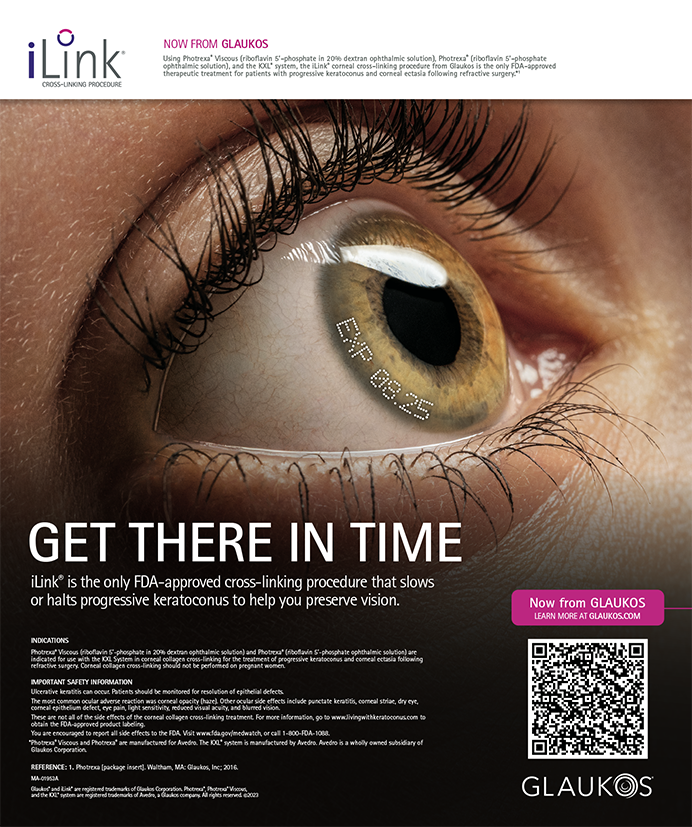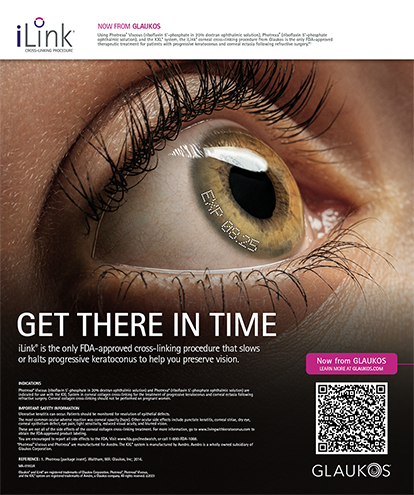In North America, more than 2 million people will undergo cataract surgery this year. This patient population is sure to intersect with that affected by glaucoma, because the prevalence of the disease by 73 years of age is 3.4 for whites and 5.7 for blacks.1
Patients who have or who are at increased risk for developing glaucoma present unique problems regarding IOL power calculations. Most commonly, the difficulty lies with pseudophakic patients who experience significantly reduced IOP following glaucoma surgery, those who have high-to-extreme axial myopia with a posterior staphyloma, those who have high-to-extreme axial hyperopia, and individuals with a history of myopic LASIK or PRK.
REDUCED IOP
With the wide acceptance of precise methods for measuring axial length such as immersion ultrasound and optical coherence biometry, the most common cause of an IOL exchange after routine cataract surgery has shifted from an error in the measurement of axial length to mistakes in keratometry.2 For the patient undergoing both cataract and glaucoma filtration surgery or the pseudophakic patient undergoing trabeculectomy or the implantation of a glaucoma drainage device, however, the situation may be quite different.3 Marked reductions in IOP may lead to a decrease in axial length and a significant shift in the postoperative refractive error. In general, a low IOP following glaucoma surgery may reduce axial length by as much as 0.60 mm. This most commonly occurs with the use of mitomycin C, in the setting of high axial myopia, and with younger patients. If the decrease is transient, the axial length may slowly return to its preoperative value as the IOP gradually increases.
If glaucoma surgery results in prolonged ocular hypotony (an IOP between 0 and 4 mm Hg), however, then the axial length may decrease by more than 1.5 mm. Individuals at risk for this dramatic change are generally younger in age and high axial myopes. When prolonged ocular hypotony occurs, the axial length generally will not return to preoperative values, and the refractive error will shift hyperopic and usually remain there. With prolonged ocular hypotony, other issues may affect the patient's visual acuity.
If surgeons are contemplating a combined procedure, and their objective is a dramatic reduction in IOP, mild-to-moderate myopia is a preferable postoperative refractive target than a plano result in order to avoid unintentional hyperopia if there is a reduction in axial length (Figure 1).
HIGH AXIAL MYOPIA
Aside from IOP-related issues, high-to-extreme axial myopia may result in erroneous IOL power calculations due to the presence of a posterior staphyloma. It is well known that the incidence of posterior staphyloma increases with increasing axial length. Although the condition is uncommon with an axial length shorter than 26.5 mm, it has been reported that a posterior staphyloma may be present in more than 70 of eyes with an axial length greater than 33.5 mm.4
In general, surgeons should always consider the possibility of a posterior staphyloma in a high axial myope if there is wide measurement-to-measurement variability during A-scan biometry combined with difficulty in obtaining a distinct retinal spike. There may also be a history of progressive myopia. The presence of an unrecognized posterior staphyloma can have a major impact on axial length measurements, because the most posterior portion of the globe (anatomic axial length) may not correspond with the center of the macula (refractive axial length). The failure to recognize a posterior staphyloma can result in an unpleasant refractive surprise following cataract surgery.5
If surgeons suspect a posterior staphyloma, they should measure the axial length using either a vector A/B-scan or optical coherence biometry with the IOLMaster (Carl Zeiss Meditec, Inc., Dublin, CA) (Figure 2).
HIGH AXIAL HYPEROPIA
High-to-extreme axial hyperopes require surgeons to measure the axial length precisely and to use a formula for calculating the IOL's power that is appropriate for this clinical setting. With a very short axial length, a relatively small error in the measurement of axial length can lead to a disproportionately large refractive surprise. In these eyes, surgeons should measure the axial length by immersion A-scan biometry or optical coherence biometry with the IOLMaster. I have found that the seven-variable Holladay 2 formula gives the most accurate refractive results in these very small eyes. Extreme axial hyperopes often require the use of two different IOLs (primary polypseudophakia) in order to achieve an adequate dioptric power.5
MYOPIC LASIK AND PRK
Prior myopic LASIK and PRK represent one of the most challenging scenarios for IOL power calculations in all of ophthalmology. At present, there is no single instrument or technique available that can consistently and directly measure the true central corneal power following this form of keratorefractive surgery. Instead, the corneal power is best estimated by multiple indirect methodologies that use both historical and objective information.
Adding to the confusion is the fact that, even if the central corneal power is accurately estimated, standard third-generation, two-variable formulas (eg, SRK/T, Hoffer Q, and Holladay 1) will frequently return an incorrect IOL power due to errors in the calculation of the effective lens position.6
I have obtained the best outcomes in these eyes using the Holladay 2 formula, which is contained within the Holladay IOL Consultant (Holladay Consulting, Inc., Bellaire, TX), and the Haigis-L formula, which is a part of the most recent version of the IOLMaster. As an alternative, surgeons may use a third-generation, two-variable formula following myopic LASIK and PRK, but they must adjust the IOL's power using an Aramberri double-K-method correction.7,8
CONCLUSION
A reduction in IOP can sometimes lead to changes in axial length. This is especially true after short- or long-term ocular hypotony. If a dramatic reduction in axial length is planned, it may be best to calculate for mild myopia rather than plano as the final postoperative target refraction.
Other clinical situations frequently associated with glaucoma can present unique challenges for IOL power calculations. These include extreme axial myopia with a peripapillary posterior staphyloma, extreme axial hyperopia and nanophthalmos, and prior myopic keratorefractive surgery.
Reprinted with permission from Glaucoma Today's September/October 2007 edition.
Warren E. Hill, MD, is Medical Director of East Valley Ophthalmology in Mesa, Arizona. He is a consultant to Carl Zeiss Meditec, Inc., and Alcon Laboratories, Inc. Dr. Hill may be reached at (480) 981-6111; hill@doctor-hill.com.


